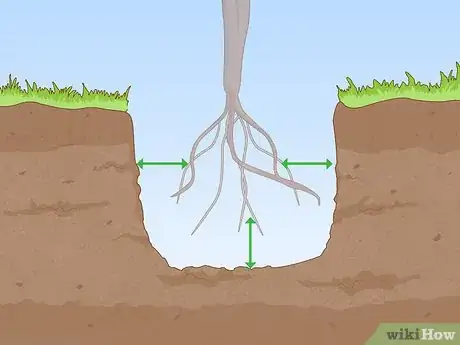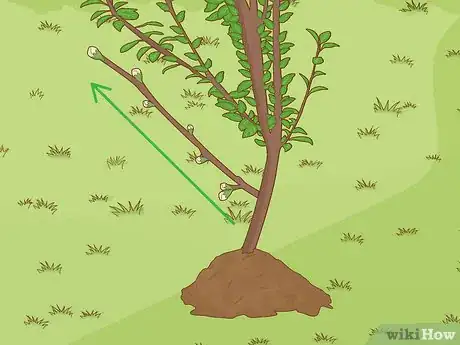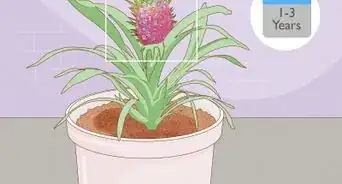This article was co-authored by Lauren Kurtz. Lauren Kurtz is a Naturalist and Horticultural Specialist. Lauren has worked for Aurora, Colorado managing the Water-Wise Garden at Aurora Municipal Center for the Water Conservation Department. She earned a BA in Environmental and Sustainability Studies from Western Michigan University in 2014.
There are 8 references cited in this article, which can be found at the bottom of the page.
This article has been viewed 33,210 times.
Growing your own plum tree in your backyard is a gratifying experience. After planting, watering, pruning, and maintaining your tree, it will bear delicious plums to reward you for your work. With regular care, your plum tree will continue to bloom and produce plums for years to come.
Steps
Choosing Your Plum Tree and Planting Site
-
1Choose a type of plum that will thrive where you live. European plum trees will grow in most climates. Japanese plum trees need warmer climates. American hybrid plums are the hardiest and can survive even in cold, harsh conditions.
- If you live in the U.S., see which “plant hardiness zone” you live in on the USDA’s website: https://planthardiness.ars.usda.gov/PHZMWeb/#
-
2Pick a European type if you have space for just one tree. Japanese plum trees and American hybrids need to cross-pollinate, which means you’d need a second tree to produce fruit. If you have space for only one tree, go with a European plum tree. It will also grow well in most climates.[1]
- In general, Japanese plums are sweet and juicy, with red skin. European plums are very sweet and purple. American hybrids vary in appearance and taste, but many are similar to Japanese plums.[2]
Advertisement -
3Start with a grafted plum tree for the best plums. A grafted plum tree is a young tree that has been attached to a rootstock of a different variety to improve its growth. Grafted plum trees produce delicious fruit. You can grow a plum tree from a plum seed, but the fruit may not taste the same.
- Dome plum varieties are only ornamental while others with bear fruit. Choose the type of plum tree that fits with the rest of your yard or garden.
- A local nursery will have plum trees that grow well in your climate.[3]
-
4Choose a planting site with well-drained soil so your tree will grow. Plum trees grow best in rich soil that isn’t constantly wet. If the soil retains water, it might cause your tree’s roots to rot. Check the drainage by digging a hole 1 foot (0.30 m) deep and filling it with water. If the water drains within 1 hour, the site has good drainage.
- If your planting site doesn’t have good drainage, choose a different spot in your yard. You can also install gutters and drains or regrade your soil to redirect water.
-
5Make sure your planting site gets 6 to 8 hours of sunlight per day. Your plum tree will need 6 to 8 hours of direct sunlight each day to grow. Avoid spots where frost might settle and spots that experience high winds.[4]
- Give your tree at least 15 feet (4.6 m) of space all around to grow. If you’re planting multiple plum trees, space them at least 18 inches (46 cm) apart.[5]
Planting the Tree
-
1Plant during spring for the easiest experience. If you live in a region with cold winters and hot summers, wait until the spring to plant your plum tree. It will be easiest to dig the hole for your tree, and your young tree’s roots will adapt to the soil well.[6]
- By planting in the spring you’ll also avoid frost, which can damage your tree.[7]
-
2Dig a hole slightly deeper and wider than the tallest, longest roots. Try not to bend the roots so they can spread and grow. Your tree's roots will grow outward. Make sure its longest roots have room to grow and form a stable base for your tree.[8]
-
3Loosen the soil in the sides of the hole so the roots can spread easily. If the soil in the hole is too compact, your roots will have trouble breaking through and growing outwards. You can loosen the soil with the tip of your shovel or a handheld tool like a trowel.[9]
-
4Check that your tree’s graft line is not submerged in the hole. The graft line is a clear line or “scar” near the base, where the root and tree join. The graft line should remain at least 1 inch (2.5 cm) above the soil when your tree is in the hole so it can grow properly.[10]
- If your hole is too deep, fill it little by little with soil you removed until the graft line is at the right position.[11]
-
5Refill the hole by packing soil around the tree’s roots. Refill the hole slowly, making sure to cover each root with soil. Adjust the angle of your tree when needed so that it stays completely upright.[12]
- Fertilizer isn’t needed when you plant a young grafted tree. Fertilizer can damage or kill the tree’s roots.[13]
-
6Water your new tree weekly for the first year. Newly planted trees need plenty of water for the first few weeks after planting. Water your tree deeply so the water soaks about 8 inches (20 cm) into your soil. Letting a tree get too dry can affect its growth and production of fruit. On the other hand, overwatering can damage the roots.[14]
Caring for Your Tree
-
1Soak the soil for 15 minutes per week once the tree is 1 year old. After your tree has been planted for a year, it doesn’t need as much water. If you live in a dry climate without much rain, soak the soil around the base of your tree with a hose for 15 to 20 minutes. If it rains once every 7 to 10 days, don’t water your tree.[15]
- Give your tree more water if its leaves are curling up and turning brown. Try watering it every 5 or 6 days at first, or soak it for 25 to 30 minutes when watering it.[16]
- Give your tree less water if its leaves are turning yellow and falling from the branches. Wait to water it every 10 or 13 days, or soak the soil for 10 minutes instead.[17]
- If you live in a humid or wet climate, your tree is probably getting plenty of moisture. Let the weather water your tree naturally when it rains.[18]
-
2Trim the branches above buds with a lopper to encourage growth. Pruning your young tree for the first time in late winter will set its shape and encourage growth the following spring. Cut branches above outward-facing buds so that the branch will grow up and out.
- Use a pruning tool that will make clean cuts, like a lopper, to discourage pests and disease.
- Cut any shoots that form on the bottom of the trunk, as they take away energy from the rest of the tree.
-
3Keep your tree healthy by clearing damaged or fallen branches. Prune branches that have broken from high winds or storms. Cut these damaged sections where they naturally meet undamaged parts of the branch to avoid leaving stubs. Rake and remove fallen debris in the fall. [19]
-
4Fertilize your tree in early spring after its first crop of fruit. Fruit trees younger than 3 or 4 years old don’t require fertilizer unless they are not growing about 10 inches (25 cm) per year. Using gloves, spread a mild, slow-release fertilizer about 1 foot (0.30 m) away from your tree’s trunk.
- A 10-10-10 ratio fertilizer is recommended for plum trees, which has equal parts nitrogen, phosphorus and potassium.[20]
-
5Use mulch around the trunk to hydrate and control weeds in the spring. Cypress mulch can cut down the evaporation of water near the soil’s surface, helping your tree conserve water. Mulch made from cedar will block weeds from sunlight so they don’t grow and affect your plum tree.[21]
- Apply mulch around the base of your tree so that it’s 2 inches (5.1 cm) thick.
- When organic mulch like cypress and cedar decomposes, it also provides nutrients to your tree so it can be used as an alternative to fertilizer.[22]
- You can make your own mulch from tree branches, bark, and leaves.
-
6Treat diseases like brown rot by pruning damaged sections. Brown rot is a common disease that affects plum trees. Withered brown twigs and flowers covered in sticky brown drops are signs of brown rot. Prune and destroy any affected fruits, twigs, leaves, and flowers.[23]
- You can also apply a fungicide like myclobutanil to treat brown rot.[24]
-
7Harvest ripe plums when they feel soft and detach from the tree easily. If you pick plums early, put them in a clean paper bag with the top folded over and let them sit at room temperature for a day or two. Your plum is ripe when your fingertip makes a small dent, but doesn’t puncture the skin. [25]
- European plums can be picked when they’re fully ripened. You can pick Japanese and American Hybrid plums slightly early and ripen them.
- Use your plums to make dishes like grilled plums or plum jam.
Community Q&A
-
QuestionWhat pest will damage the plums?Plum tree pests include mites, Japanese beetles, and aphids. You can use pesticides or a more natural way to get rid of these pests.
Things You’ll Need
- Grafted plum tree
- Shovel
- Trowel
- Hose
- Pruning tool
- Fertilizer
- Mulch
- Fungicide
References
- ↑ https://www.gardenguides.com/111175-care-plum-tree.html
- ↑ https://garden.org/learn/articles/view/1398/
- ↑ http://www.davewilson.com/home-gardens/growing-fruits-and-nuts/planting-your-backyard-orchard
- ↑ https://www.almanac.com/plant/plums#
- ↑ https://www.almanac.com/plant/plums#
- ↑ https://www.almanac.com/plant/plums#
- ↑ https://www.almanac.com/plant/plums#
- ↑ http://www.davewilson.com/home-gardens/growing-fruits-and-nuts/planting-your-backyard-orchard
- ↑ http://www.davewilson.com/home-gardens/growing-fruits-and-nuts/planting-your-backyard-orchard
- ↑ https://goldcoastlandscapegardening.com.au/2013/01/18/looking-after-your-grafted-fruit-trees/
- ↑ http://www.davewilson.com/home-gardens/growing-fruits-and-nuts/planting-your-backyard-orchard
- ↑ https://www.almanac.com/plant/plums#
- ↑ http://www.davewilson.com/home-gardens/growing-fruits-and-nuts/planting-your-backyard-orchard
- ↑ https://www.almanac.com/plant/plums#
- ↑ https://www.gardenguides.com/82915-water-plum-trees.html
- ↑ https://www.gardenguides.com/82915-water-plum-trees.html
- ↑ https://www.gardenguides.com/82915-water-plum-trees.html
- ↑ http://homeorchard.ucanr.edu/The_Big_Picture/Irrigation/
- ↑ https://www.almanac.com/plant/plums#
- ↑ https://www.almanac.com/plant/plums#
- ↑ http://www.davewilson.com/home-gardens/growing-fruits-and-nuts/cultural-practices/water-and-mulch
- ↑ http://www.davewilson.com/home-gardens/growing-fruits-and-nuts/cultural-practices/water-and-mulch
- ↑ https://www.gardenguides.com/111175-care-plum-tree.html
- ↑ https://www.gardenguides.com/111175-care-plum-tree.html
- ↑ https://www.gardenguides.com/111175-care-plum-tree.html













































































